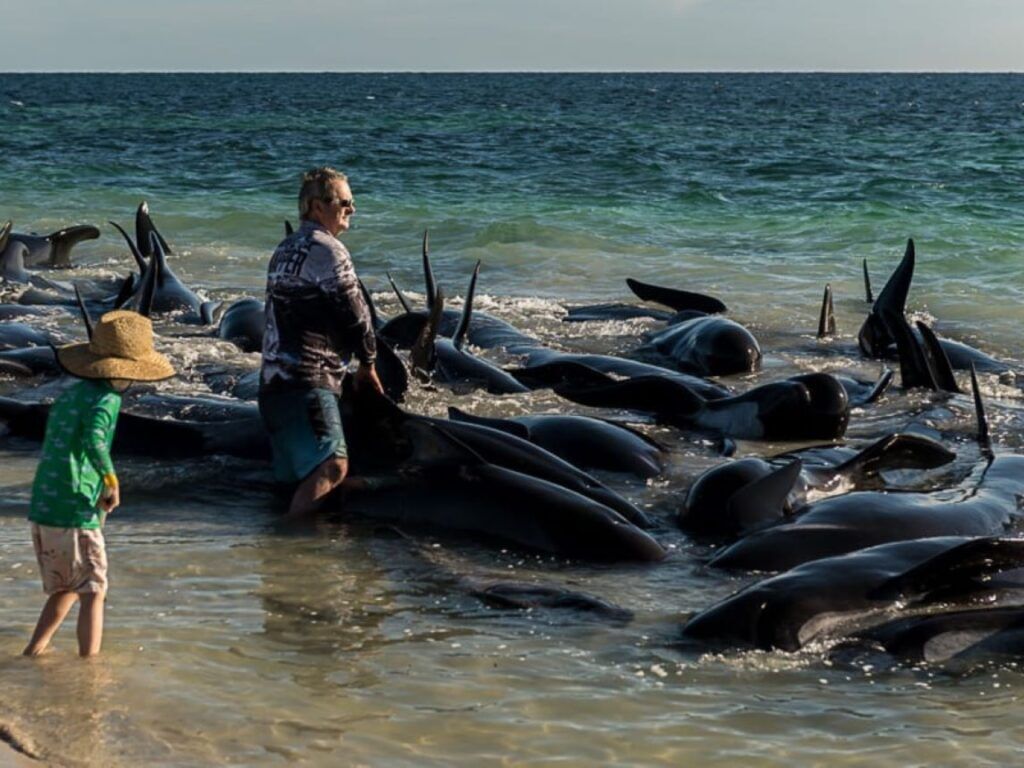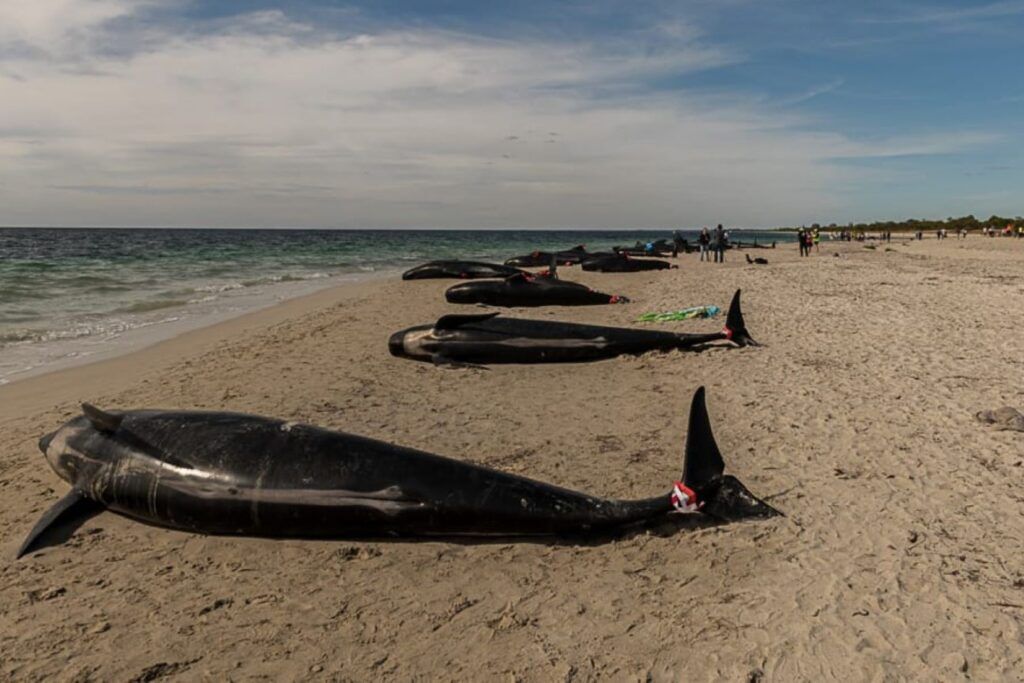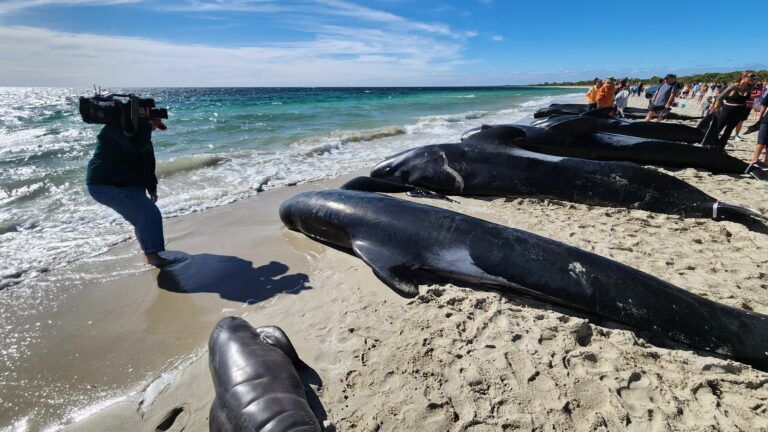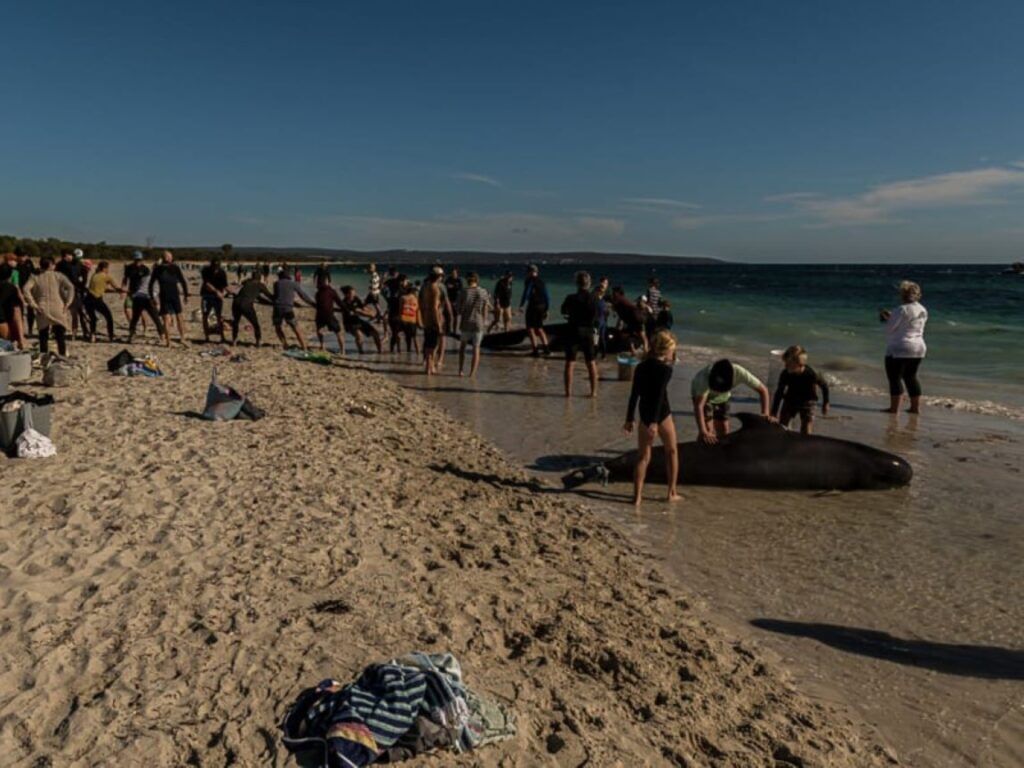Bodies of 160 pilot whales lay stranded on an Australian beach, mysteriously they save themselves
As people organized to pull the dead whales out of the water and onto the beach, they circled the massive bodies and prayed, bidding farewell to these majestic creatures. The emotional weight hung heavy in the air.
Mariela Laksman
June 28, 2024


JOURNALIST’S NOTES
INTERVIEW SUBJECT
Ian Wiese, director of Geographe Marine Research (GMR) in Dunsborough, is a retired IT developer with over 50 years of experience. His expertise spans programming, systems and database design, engineering simulation, and SCADA systems. Ian has worked with the Western Australian Water Corporation and completed international consulting assignments. Since retiring, he’s focused on cetacean research in Geographe Bay, applying his IT skills to develop a Lidar-based system for small drones to study whales. GMR, a non-profit charity and CSIRO-approved research institute, supports marine research, particularly cetacean studies.
BACKGROUND INFORMATION
More than 100 long-finned pilot whales that stranded along the shores of Western Australia was successfully guided back into the ocean, while unfortunately, 29 whales did not survive. .
Following the rescue efforts where marine officials and volunteers assisted the remaining whales back out to sea, boats remained on standby and a spotter plane monitored the area to prevent any whales from returning to shore. The stranding involved four pods totaling 160 pilot whales along approximately 1,640 feet of beach at Toby Inlet near Dunsborough, Western Australia.
GEOGRAPHE BAY, Australia — Early in the morning on April 25, 2024, I received an urgent message from one of our directors. Startled, I picked up my mobile phone. When I heard the news, I froze. A massive stranding of long-finned pilot whales occurred just three kilometers from my home. Without hesitation, I notified the local authorities, grabbed my car keys, and raced towards the beach.
When I arrived, I walked along the sand and witnessed the full extent of the disaster. One hundred and sixty pilot whales lay scattered across the beach, clustered in shallow water, desperately fighting for their lives. The stranded whales stretched along the coastline, covering nearly 500 meters. Some whales had already perished, and I feared more would follow as the morning went on.
Read more environment stories at Orato World Media.
Several stranded pilot whales tragically succumbed despite tireless efforts to save them
Growing up in Busselton, a small coastal town in Geographe Bay, I never saw whales. The whaling industry nearly wiped them out. By the 1960s, several species neared extinction. Blue whales and southern right whales, once abundant, now numbered only a few hundred worldwide. Learning about their plight stirred a deep desire within me—a passion to protect these magnificent creatures.
On April 25, when I arrived at the beach, I encountered an overwhelming and distressing scene. Hundreds of people already gathered there, and the crowd steadily grew. Television crews arrived, and journalists set up their cameras to capture the tragic sight. Witnessing pilot whales struggling for their lives, I steeled myself. The urgency gripped us all, preparing us for the challenging task ahead.
In the water, we tirelessly worked to ease their suffering. We shielded them from the sun and ensured they stayed hydrated. Neighbors, veterinarians, marine scientists, wildlife experts, and our dedicated volunteers from Geographe Marine Research joined forces. We fought to keep the whales afloat, their blowholes above water so they could breathe.
We learned from past incidents that euthanasia was often the most ‘humane’ course of action. Yet, this time, we pushed ourselves to the limit, determined to do everything in our power. Unfortunately, despite our determined efforts, we grappled with grief as some of the whales succumbed. My heart ached, particularly for the smaller ones, their final breaths leaving a heavy burden on my soul.
Amidst prayers and warnings, the stranded whales’ unexpected return astonished the crowd
As people organized to pull the dead whales out of the water and onto the beach, they circled the massive bodies and prayed, bidding farewell to these majestic creatures. The emotional weight hung heavy in the air.
Hours passed without anyone finding a solution. The Parks and Wildlife officials stepped in, warning the crowd about the potential danger of attracting sharks. They urged people to leave the water. Yet, some remained magnetized by the situation, including small children. I waved my hands, urging them to safety.


Suddenly, a white-tipped shark appeared nearby, causing chaos as people scrambled toward the shore. Then, almost miraculously, the surviving whales began swimming ashore. The stranded ones turned and swam away as if an unseen force guided them. I watched in awe as I witnessed this astonishing sight. Within minutes, the whales vanished, leaving the crowd captivated. Pods of them sailed along the coast, merging seamlessly with the sea. Amidst it all, the little calf waited for its mother’s return.
The organization seeks community help to gather data and uncover the causes of the whale stranding
The next day, I returned to the area and found the same calf I saw the previous day. Only two weeks old, the calf became separated from its mother, who likely died on the beach the day before. My heart ached for the calf. Without its mother, it faced impossible odds for survival. Yet, throughout my stay, the little one reamined steadfast, waiting for a reunion that would never come.


Everyone asks the same question: “What drives this behavior?” The answer eludes us. Numerous theories exist, some plausible, others less so. Pilot whales, typically deep-sea dwellers, rarely venture so close to shore. Perhaps their navigation systems faltered, leading them astray. But why do some strandings result in dismal survival rates while others, like this one, yield remarkable success?
As we collect more data, we gradually enhance our understanding in order to manage these events. Our organization used social media to urge those who took photographs to share them. By piecing together a chronology of events, we aim to uncover the triggers that prompted these whales to embark on their own rescue mission.










Chinese President Xi Jinping delivers a speech at the Conference Marking the 70th Anniversary of the Five Principles of Peaceful Coexistence in Beijing, China, June 28, 2024. /Chinese Foreign Ministry
The Five Principles of Peaceful Coexistence were proposed 70 years ago.
Having emerged in a complex historical context, the five principles have been gradually accepted by countries worldwide and become fundamental norms for maintaining international peace and security and promoting friendly relations among nations.
At a commemorative conference marking 70 years of the principles, held by China on Friday, Chinese President Xi Jinping called for the principles to be carried forward to build a community with a shared future for mankind and provide a strong driving force for human progress.
'Firm resolve' to peaceful development
In 1954, then Chinese Premier Zhou Enlai put forth in full the Five Principles of Peaceful Coexistence for the first time – mutual respect for sovereignty and territorial integrity, mutual non-aggression, non-interference in each other's internal affairs, equality and mutual benefit, and peaceful coexistence.
Later, these principles served as guidelines for countries with different historical and cultural backgrounds, social systems and national conditions to handle their interrelations.
Noting the five principles have withstood the test of international vicissitudes, Xi said in the speech at Friday's conference that 70 years on, China has answered the call of the times by proposing a community with a shared future for mankind.
The Chinese president said that the Vision of Building a Community with a Shared Future for Mankind, carrying forward the spirit of the five principles, is the most effective way to sustain, promote and upgrade these principles, demonstrating China's firm resolve to follow the path of peaceful development.
China is the only country in the world that has incorporated peaceful development in its Constitution, and the only country among the five nuclear-weapon states to pledge no first use of nuclear weapons.
In April 2022, China proposed the Global Security Initiative to create a new path to security featuring dialogue over confrontation, partnership over alliance, and win-win over zero-sum. Under its guidance, the country released papers on its position on resolving the Ukraine crisis and the Palestinian-Israeli conflict, respectively, urging political settlement and diplomatic mediation.
Guiding Global South cooperation
The five principles were initiated with the purpose of protecting the interests and pursuits of small and weak countries from power politics. As the international order is being rebuilt based on South-South cooperation, the five principles are gaining ground and guiding solidarity and collaboration among Global South countries.
Under the China-proposed Belt and Road Initiative (BRI), many participating countries have reinforced their capacity of development through cooperating with China on fields including transportation, agriculture, energy and communication.
This is demonstrated by BRI landmark projects such as the China-Laos Railway which turned landlocked Laos into a land transport hub, Kenya's Mombasa-Nairobi Railway which contributes two percent to the African nation's economic growth, and Indonesia's Jakarta-Bandung High-Speed Railway, the first high-speed railway in Southeast Asia.
In the speech, Xi put forward a series of suggestions to better support Global South cooperation, such as providing 100,000 training opportunities to Global South countries in the coming five years, discussing free trade arrangements with more Global South countries, and welcoming more Global South countries to join the Initiative on International Trade and Economic Cooperation Framework for Digital Economy and Green Development.
He noted that China's imports from fellow developing countries are expected to exceed $8 trillion between now and 2030.
"Standing at a new historical starting point, the Global South should be more open and more inclusive, and join hands together to take the lead in building a community with a shared future for mankind," said the Chinese president.